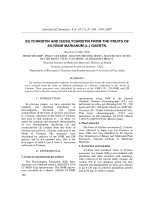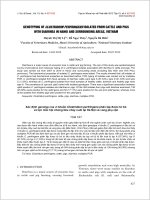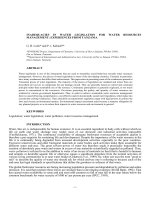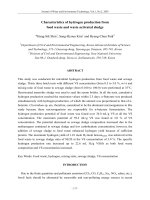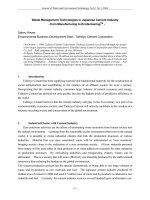surfactants from renewable resources
Bạn đang xem bản rút gọn của tài liệu. Xem và tải ngay bản đầy đủ của tài liệu tại đây (2.63 MB, 343 trang )
Surfactants from
Renewable Resources
Edited by
MIKAEL KJELLIN
YKI, Institute for Surface Chemistry, Stockholm, Sweden
INGEG
¨
ARD JOHANSSON
AkzoNobel Surfactants, Stenungsund, Sweden
A John Wiley and Sons, Ltd., Publication
Surfactants from Renewable
Resources
Wiley Series
in
Renewable Resources
Series Editor
Christian V. Stevens, Department of Organic Chemistry, Ghent University, Belgium
Titles in the Series
Wood Modification: Chemical, Thermal and Other Processes
Callum A. S. Hill
Renewables-Based Technology: Sustainability Assessment
Jo Dewulf & Herman Van Langenhove
Introduction to Chemicals from Biomass
James H. Clark & Fabien E. I. Deswarte
Biofuels
Wim Soetaert & Erick Vandamme
Handbook of Natural Colorants
Thomas Bechtold & Rita Mussak
Surfactants from Renewable Resources
Mikael Kjellin & Ingeg
¨
ard Johansson
Forthcoming Titles
Industrial Application of Natural Fibres: Structure, Properties
and Technical Applications
Jorg M
¨
ussig
Thermochemical Processing of Biomass
Robert C. Brown
Surfactants from
Renewable Resources
Edited by
MIKAEL KJELLIN
YKI, Institute for Surface Chemistry, Stockholm, Sweden
INGEG
¨
ARD JOHANSSON
AkzoNobel Surfactants, Stenungsund, Sweden
A John Wiley and Sons, Ltd., Publication
This edition first published 2010
c
2010 John Wiley & Sons, Ltd
Registered office
John Wiley & Sons Ltd, The Atrium, Southern Gate, Chichester, West Sussex, PO19 8SQ, United Kingdom
For details of our global editorial offices, for customer services and for information about how to apply for
permission to reuse the copyright material in this book please see our website at www.wiley.com.
The right of the author to be identified as the author of this work has been asserted in accordance with the
Copyright, Designs and Patents Act 1988.
All rights reserved. No part of this publication may be reproduced, stored in a retrieval system, or transmitted,
in any form or by any means, electronic, mechanical, photocopying, recording or otherwise, except as permitted
by the UK Copyright, Designs and Patents Act 1988, without the prior permission of the publisher.
Wiley also publishes its books in a variety of electronic formats. Some content that appears in print may not
be available in electronic books.
Designations used by companies to distinguish their products are often claimed as trademarks. All brand names
and product names used in this book are trade names, service marks, trademarks or registered trademarks of
their respective owners. The publisher is not associated with any product or vendor mentioned in this book.
This publication is designed to provide accurate and authoritative information in regard to the subject matter
covered. It is sold on the understanding that the publisher is not engaged in rendering professional services. If
professional advice or other expert assistance is required, the services of a competent professional should be
sought.
The publisher and the author make no representations or warranties with respect to the accuracy or completeness
of the contents of this work and specifically disclaim all warranties, including without limitation any implied
warranties of fitness for a particular purpose. This work is sold with the understanding that the publisher is not
engaged in rendering professional services. The advice and strategies contained herein may not be suitable for
every situation. In view of ongoing research, equipment modifications, changes in governmental regulations,
and the constant flow of information relating to the use of experimental reagents, equipment, and devices,
the reader is urged to review and evaluate the information provided in the package insert or instructions for
each chemical, piece of equipment, reagent, or device for, among other things, any changes in the instructions
or indication of usage and for added warnings and precautions. The fact that an organization or Website is
referred to in this work as a citation and/or a potential source of further information does not mean that the
author or the publisher endorses the information the organization or Website may provide or recommendations
it may make. Further, readers should be aware that Internet Websites listed in this work may have changed
or disappeared between when this work was written and when it is read. No warranty may be created or
extended by any promotional statements for this work. Neither the publisher nor the author shall be liable for
any damages arising herefrom.
Library of Congress Cataloging-in-Publication Data
Surfactants from renewable resources / editors, Mikael Kjellin, Ingegard Johansson.
p. cm.
Includes bibliographical references and index.
ISBN 978-0-470-76041-3
1. Surface active agents. 2. Environmental chemistry – Industrial applications. I. Kjellin, Mikael.
II. Johansson, Ingeg
¨
ard.
TP994.S8735 2010
668
.1 – dc22
2009036215
A catalogue record for this book is available from the British Library.
ISBN 978-0-470-76041-3 (H/B)
Typeset in 10/12pt Times-Roman by Laserwords Private Limited, Chennai, India.
Printed and bound in Great Britain by Antony Rowe Ltd., Chippenham, Wiltshire
Contents
Series Preface xi
Preface xiii
Acknowledgements xvii
List of Contributors xix
Part 1 Renewable Hydrophobes 1
1 Surfactants Based on Natural Fatty Acids 3
Martin Svensson
1.1 Introduction and History 3
1.2 Fats and Oils as Raw Materials 4
1.3 Fatty Acid Soaps 5
1.4 Polyethylene Glycol Fatty Acid Esters 10
1.5 Polyglycerol Fatty Acid Esters 11
1.6 Conclusions 13
References 15
2 Nitrogen Derivatives of Natural Fats and Oils 21
Ralph Franklin
2.1 Introduction 21
2.2 Manufacture of Fatty Nitrogen Derivatives 22
2.3 Production Data 30
2.4 Ecological Aspects 30
2.5 Biodegradation 31
2.6 Properties of Nitrogen-Based Surfactants 33
2.7 Applications 35
2.8 Conclusions 39
References 40
vi Contents
3 Surface-Active Compounds as Forest-Industry By-Products 45
Bjarne Holmbom, Anna Sundberg and Anders Strand
3.1 Introduction 45
3.2 Resin and Fatty Acids 46
3.3 Sterols and Sterol Ethoxylates 54
3.4 Hemicelluloses 56
Acknowledgements 58
References 59
Part 2 Renewable Hydrophiles 63
4 Surfactants Based on Carbohydrates and Proteins for Consumer
Products and Technical Applications 65
Karlheinz Hill
4.1 Introduction 65
4.2 Raw Materials 65
4.3 Products and Applications 67
4.4 Conclusion 81
Acknowledgements 81
References 81
5 Amino Acids, Lactic Acid and Ascorbic Acid as Raw Materials
for Biocompatible Surfactants 85
Carmen Moran, Lourdes Perez, Ramon Pons, Aurora Pinazo
and Maria Rosa Infante
5.1 Introduction 85
5.2 Production of Raw Materials 86
5.3 Lysine-Based Surfactants 87
5.4 Lactic Acid-Based Surfactants 94
5.5 Ascorbic Acid-Based Surfactants 97
References 100
Part 3 New Ways of Making Renewable Building Blocks 109
6 Ethylene from Renewable Resources 111
Anna Lundgren and Thomas Hjertberg
6.1 Introduction 111
6.2 Why Produce Ethylene from Renewable Resources? 113
6.3 Production of Ethylene from Renewable Feedstock 115
6.4 Commercialization of Bioethylene 121
6.5 Environmental Impact of Bioethylene 123
6.6 Certificate of Green Carbon Content 124
6.7 Concluding Remarks 125
References 125
Contents vii
7 Fermentation-Based Building Blocks for Renewable Resource-Based
Surfactants 127
Kris Arvid Berglund, Ulrika Rova and David B. Hodge
7.1 Introduction 127
7.2 Existing and Potential Classes of Surfactants from Biologically
Derived Metabolites 129
7.3 Fermentation-Based Building Blocks with Large Existing Markets 131
7.4 New Fermentation-Based Building Blocks 133
7.5 Conclusion 138
References 138
Part 4 Biosurfactants 143
8 Synthesis of Surfactants Using Enzymes 145
Patrick Adlercreutz and Rajni Hatti-Kaul
8.1 Introduction 145
8.2 Enzymes as Catalysts for Synthesis of Surfactants 146
8.3 Enzymatic Synthesis of Polar Lipids Useful as Surfactants 147
8.4 Carbohydrate Esters 148
8.5 Fatty Amide Surfactants 151
8.6 Amino Acid-Based Surfactants 155
8.7 Alkyl Glycosides 158
8.8 Future Prospects 160
Acknowledgements 161
References 161
9 Surfactants from Waste Biomass 167
Flor Yunuen Garc´ıa-Becerra, David Grant Allen and Edgar Joel Acosta
9.1 Introduction 167
9.2 Surfactants Obtained from Biological Transformation of Waste
Biomass 168
9.3 Surfactants Obtained from Chemical Transformation of Waste
Biomass 177
9.4 Summary and Outlook 185
References 185
10 Lecithin and Other Phospholipids 191
Willem van Nieuwenhuyzen
10.1 Introduction 191
10.2 Sources and Production 191
10.3 Composition 195
10.4 Quality and Analysis of Lecithins 196
10.5 Modification 198
10.6 Emulsifying Properties 203
viii Contents
10.7 Applications 206
10.8 Legislation and Reach 209
10.9 Conclusion 211
References 211
11 Sophorolipids and Rhamnolipids 213
Dirk W. G. Develter and Steve J. J. Fleurackers
11.1 Sophorolipids 213
11.2 Derivatives of Native Sophorolipids 224
11.3 Biosynthesis of Novel Sophorolipids 227
11.4 Rhamnolipids 230
11.5 Cleaning Applications Using Sophorolipids and Rhamnolipids 234
References 236
12 Saponin-Based Surfactants 239
Wieslaw Oleszek and Arafa Hamed
12.1 Introduction 239
12.2 Molecular Properties 240
12.3 Sources of Saponins 242
12.4 Saponins as Emulsifiers and Surfactants 242
12.5 Application of Saponins as Surfactants and Emulsifiers 245
Acknowledgements 248
References 248
Part 5 Polymeric Surfactants/Surface-Active Polymers 251
13 Surface-Active Polymers from Cellulose 253
Leif Karlson
13.1 Introduction 253
13.2 Structure and Synthesis of Cellulose Ether 254
13.3 Cellulose Ethers in Aqueous Solution 257
13.4 Interaction with Surfactants 262
13.5 Clouding 263
References 265
14 New Developments in the Commercial Utilization of Lignosulfonates 269
Rolf Andreas Lauten, Bernt O. Myrvold and Stig Are Gundersen
14.1 Introduction 269
14.2 Lignosulfonates 269
14.3 Lignosulfonate Production 271
14.4 Environmental Issues 272
14.5 Lignosulfonates as Stabilizers for Emulsions and Suspoemulsions 274
Contents ix
14.6 Superplasticizers for Concrete 279
14.7 Summary 280
Acknowledgements 281
References 281
15 Dispersion Stabilizers Based on Inulin 285
Tharwat Tadros and Bart Levecke
15.1 Introduction 285
15.2 Solution Properties of Long-Chain Inulin and Hydrophobically
Modified Inulin (HMI) 288
15.3 Interfacial Aspects of HMI at Various Interfaces 289
15.4 Emulsions Stabilized Using HMI 290
15.5 Emulsion Polymerization Using HMI 293
15.6 Use of HMI for Preparation and Stabilization of Nanoemulsions 295
References 300
Index 303
Series Preface
Renewable resources, their use and modification are involved in a multitude of important
processes with a major influence on our everyday lives. Applications can be found in
the energy sector, chemistry, pharmacy, the textile industry, paints and coatings, to name
but a few.
The area interconnects several scientific disciplines (agriculture, biochemistry, chem-
istry, technology, environmental sciences, forestry, etc.), which makes it very difficult to
have an expert view on the complicated interaction. Therefore, the idea to create a series
of scientific books, focusing on specific topics concerning renewable resources, has been
very opportune and can help to clarify some of the underlying connections in this area.
In a very fast changing world, trends are not only characteristic for fashion and political
standpoints, also science is not free from hypes and buzzwords. The use of renewable
resources is again more important nowadays; however it is not part of a hype or a fashion.
As the lively discussions among scientists continue about how many years we will still
be able to use fossil fuels, with opinions ranging from 50 to 500 years, they do agree that
the reserve is limited and that it is essential not only to search for new energy carriers
but also for new material sources.
In this respect, renewable resources are a crucial area in the search for alternatives
for fossil-based raw materials and energy. In the field of energy supply, biomass and
renewable-based resources will be part of the solution alongside other alternatives such
as solar energy, wind energy, hydraulic power, hydrogen technology and nuclear energy.
In the field of material sciences, the impact of renewable resources will probably be
even bigger. Integral utilization of crops and the use of waste streams in certain industries
will grow in importance, leading to a more sustainable way of producing materials.
Although our society was much more (almost exclusively) based on renewable
resources centuries ago, this disappeared in the Western world in the nineteenth century.
Now it is time to focus again on this field of research. However, it should not mean a
retour `a la nature, but it should be a multidisciplinary effort on a highly technological
level to perform research towards new opportunities and to develop new crops and
products from renewable resources. This will be essential to guarantee a level of
comfort for a growing number of people living on our planet. It is ‘the’ challenge for the
coming generations of scientists to develop more sustainable ways to create prosperity
and to fight poverty and hunger in the world. A global approach is certainly favoured.
xii Series Preface
This challenge can only be dealt with if scientists are attracted to this area and are
recognized for their efforts in this interdisciplinary field. It is therefore also essential that
consumers recognize the fate of renewable resources in a number of products.
Furthermore, scientists do need to communicate and discuss the relevance of their
work. The use and modification of renewable resources may not follow the path of
the genetic engineering concept in view of consumer acceptance in Europe. Related to
this aspect, the series will certainly help to increase the visibility of the importance of
renewable resources.
Being convinced of the value of the renewables approach for the industrial world, as
well as for developing countries, I was myself delighted to collaborate on this series of
books focusing on different aspects of renewable resources. I hope that readers become
aware of the complexity, the interaction and interconnections, and the challenges of this
field and that they will help to communicate the importance of renewable resources.
I certainly want to thank the people of Wiley from the Chichester office, especially
David Hughes, Jenny Cossham and Lyn Roberts, in seeing the need for such a series of
books on renewable resources, for initiating and supporting it and for helping to carry
the project to the end.
Last, but not least, I want to thank my family, especially my wife Hilde and children
Paulien and Pieter-Jan, for their patience and for giving me the time to work on the
series when other activities seemed to be more inviting.
Christian V. Stevens,
Faculty of Bioscience Engineering
Ghent University, Belgium
Series Editor ‘Renewable Resources’
June 2005
Preface
Surfactants are molecules that consist of one hydrophilic (water-loving) part and one
hydrophobic (water-hating or oil-loving) part. The production of a surfactant is essen-
tially a question of joining different types of these two categories with one another.
Renewability refers to the sources for the hydrophilic and the hydrophobic groups.
There has been a substantial development during the last century to construct molecules
that are more efficient than the fatty acid soaps that have been produced for over 2000
years. As pointed out in the chapter on surfactants (Oleochemical and Petrochemical
Surfactants: An Overall Assessment) in the first book in the series about renewable
products (Renewables-Based Technology: Sustainability Assessment), most surfactants
today are readily biodegradable and low-toxic to the aquatic environment, which are
the two criteria for ‘green surfactants’. The majority of these surfactants are, however,
synthesized from petroleum, which of course is non-renewable. This book will focus
on renewable sources for surfactants that are also readily biodegradable and how an
increased use of renewable sources might be achieved.
When it comes to the hydrophobic part of a surfactant, the natural oleochemical source
predominantly offers straight hydrophobic chains with even amounts of carbon atoms.
These structures are not always optimal and it has been shown that some branching that
does not destroy the biodegradability is preferable from a performance point of view in
many applications like cleaning, wetting, etc. On the hydrophilic side, one of the most
interesting structural elements that forms the non-ionic surfactants as well as some of the
anionic surfactants is ethylene oxide, which at present is made from petroleum sources,
i.e. ethylene.
In both cases there are ways of making building blocks from ‘natural’ sources, for
instance from ethanol from fermentation processes using ‘green chemistry’. There are
activities reviving the processes that were used as late as in the 1950s to produce a whole
range of small and larger building blocks from ethanol, starting with acetaldehyde and
condensing that to larger branched aldehydes, as well as producing ethylene that could
be polymerized to polyethene or oxidized to ethylene oxide.
One could argue that the high-tech surfactants that we use today offer much less
burden for the environment than the less efficient, more primitive versions of renewable
surfactants that were made earlier, e.g. from fatty acid. Developing the ‘green routes’
xiv Preface
to these advanced surfactants via green building blocks is then an important task for the
future and efforts in this direction are thus reported in this book.
Another stumbling block on the road to renewable sources for surfactants are the market
issues that come as a consequence of an increasing use of oleochemicals as fuels such
as biodiesel. Due to subsidies the market is very much influenced by the support from
governments, resulting in an increasing price for the classical hydrophobe sources. Not
only cost but also availability is influenced, which in the end might result in a decrease
in possible raw material amounts. This development is illustrated in Figure 1 where the
price level for fatty acids is followed through the years 2004–2008. There is an obvious
dependence on the diesel price which makes the level vary in an unforeseeable way.
Yet another complication is the property demand on the structure of the hydrocarbon
chain, which is totally different when the oleochemical is used as an energy source from
when it is used as the hydrophobic part of a surfactant. To produce energy through
combustion you just need a certain amount of carbon material, but for a surfactant the
behaviour is mostly determined by the length and structure of the hydrophobe. This
means that, for example, tallow oil cannot be easily substituted by, for instance, palm
oil to get the same surfactant properties. Therefore, if a couple of major power plants
choose to use tallow oil for their combustion, they could easily consume the total amount
produced in Europe. This would be a rather attractive option for the tallow producers,
having to deal with only a couple of large-scale customers prepared to pay premium
250
350
450
550
650
750
850
950
1050
1150
2
004-06-01
2
004-09-07
2
004-12-14
2
005-03-24
2
005-07-06
2
005-10-12
2
006-01-19
2
006-05-01
2
006-08-09
2
006-11-15
2
007-02-26
2
007-06-11
2
007-09-17
2
007-12-24
2
008-04-07
2
008-07-17
2
008-10-23
Euro/MT
palmoil
soyoil
rapeoil
EU tallow
diesel 10ppm
Figure 1 Correlation between the prices for different raw materials between 2004 and 2008.
Source: AkzoNobel
Preface xv
prices, having fewer delivery points, lower demands on quality and higher prices due to
subsidies. The market might then be forced to go back to petroleum-based sources for
surfactant production, i.e. synthetic fatty alcohols – a development that is not wished
for by anyone.
It is thus important to create knowledge and awareness of the complicated issues
involved in the raw material source uses when the market is driven by forces other than
natural competition.
In this book you will find reviews treating both the traditional sources for hydrophobic
as well as hydrophilic parts of surfactants, and some newer attempts. We have chosen
to concentrate on issues that have an obvious potential for large-scale use and not the
more academic investigations, however interesting they might be.
In the first part of the book we treat surfactant raw materials from different sources,
crops, animals and wood, touching upon the biorefinery concept including carbohydrates
and amino acids and short carboxylic acids like lactic acid, citric acid, etc.
The rest is devoted to different ways of creating new resources, i.e. green ethylene
from green ethanol and complex mixtures from waste biomass. A high-flying concept like
using algae as a new source is only mentioned very briefly since large-scale experience
and knowledge is still lacking.
On top of that, green ways of using these raw materials, for instance in enzymatic
processes or microorganism systems, are treated. An example of the use of living cells
is the production of sophorolipids and rhamnolipids to be integrated in new ‘green’
detergents that have found their way to the market in the last 10–15 years and thus can
be considered to be an established type of biosurfactant.
A few surface-active structures can be extracted directly from nature, such as lecithin
and saponin. They are reviewed in separate chapters, showing that these historic types of
surface-active materials are still in use in important areas like food and feed production
and various cleaning applications.
Finally, the area is enlarged a bit by looking at larger surface-active molecules that one
could describe as surface-active polymers or polymeric surfactants. Here mature types
of products like cellulose derivatives and lignosulfonates, as well as the newer inulin
products, are treated.
Mikael Kjellin
Ingeg
¨
ard Johansson
Stockholm/Stenungsund, Sweden
2009
Acknowledgements
The editors for this book met in 1995 when the Centre for Surfactants Based on Natural
Products (SNAP) started. Mikael was then a PhD student in surface chemistry at the
Royal Institute of Technology and Ingeg
¨
ard an industrial research leader at AkzoNobel
Surface Chemistry in Stenungsund. In total, six academic and thirteen industrial partners
collaborated within SNAP with the common goal to explore properties and applications
of the next-generation environmentally friendly surfactants. The main outcome of the
centre activities was 22 PhDs and over 200 scientific publications.
The networks between academic and industrial researchers created during the life-
time of SNAP also laid the foundation for future research collaborations. Two ongoing
examples are the Controlled Delivery and Release Centre (CODIRECT) at the Insti-
tute for Surface Chemistry (YKI) and the Supramolecular Biomaterial Center (SuMo
Biomaterials) at Chalmers University of Technology.
We thank our employers, the Institute for Surface Chemistry (YKI) and AkzoNobel
Surface Chemistry, for giving us the opportunity to work with this book, which we feel
covers an important topic for the future. We would also particularly like to thank all
the authors for their contributions and for answering all our questions on top of all their
other duties in their company or academic surroundings.
List of Contributors
Edgar Joel Acosta Department of Chemical Engineering & Applied Chemistry,
University of Toronto, Canada
Patrick Adlercreutz Department of Biotechnology, Lund University, Sweden
David Grant Allen Department of Chemical Engineering & Applied Chemistry,
University of Toronto, Canada
Kris Arvid Berglund Division Chemical Engineering, Lule
˚
a University of Technology,
Sweden
Dirk W. G. Develter Ecover Belgium NV, Malle, Belgium
Steve J. J. Fleurackers Ecover Belgium NV, Malle, Belgium
Ralph Franklin AkzoNobel Surfactants, Brewster, USA
Flor Yunuen Garc
´
ıa-Becerra Department of Chemical Engineering & Applied
Chemistry, University of Toronto, Canada
Stig Are Gundersen Borregaard LignoTech, Sarpsborg, Norway
Arafa Hamed Department of Botany, Aswan Faculty of Science, South Valley
University, Aswan, Egypt
Rajni Hatti-Kaul Department of Biotechnology, Lund University, Sweden
Karlheinz Hill Cognis GmbH, Monheim, Germany
Thomas Hjertberg Borealis AB, Stenungsund, Sweden
David B. Hodge Division Chemical Engineering, Lule
˚
a University of Technology,
Sweden
Bjarne Holmbom Process Chemistry Centre,
˚
Abo Akademi University, Finland
MariaRosaInfante Instituto de Qu
´
ımica Avanzada de Catalu
˜
na, Barcelona, Spain
Leif Karlson AkzoNobel Functional Chemicals, Stenungsund, Sweden
xx List of Contributors
Rolf Andreas Lauten Borregaard Corporate R&D, LignoTech Group, Sarpsborg,
Norway
Bart Levecke Beneo Bio Based Chemicals, a Division of Beneo-Remy NV, Leuven-
Wijgmaal, Belgium
Anna Lundgren Stiftelsen Chalmers Industriteknik, Gothenburg, Sweden
Carmen Moran Chemistry Department, Coimbra University, Coimbra, Portugal
Bernt O. Myrvold Borregaard Corporate R&D, LignoTech Group, Sarpsborg, Norway
Willem van Nieuwenhuyzen Lecipro Consulting, Limmen, The Netherlands
Wieslaw Oleszek Institute of Soil Science and Plant Cultivation, State Research
Institute, Pulawy, Poland
Lourdes Perez Instituto de Qu
´
ımica Avanzada de Catalu
˜
na, Barcelona, Spain
Aurora Pinazo Instituto de Qu
´
ımica Avanzada de Catalu
˜
na, Barcelona, Spain
Ramon Pons Instituto de Qu
´
ımica Avanzada de Catalu
˜
na, Barcelona, Spain
Ulrika Rova Division Chemical Engineering, Lule
˚
a University of Technology, Sweden
Anders Strand Process Chemistry Centre,
˚
Abo Akademi University, Finland
Anna Sundberg Process Chemistry Centre,
˚
Abo Akademi University, Finland
Martin Svensson Lantm
¨
annen Food R&D AB, Stockholm, Sweden
Tharwat Tadros Consultant, Wokingham, UK
Part 1
Renewable Hydrophobes


